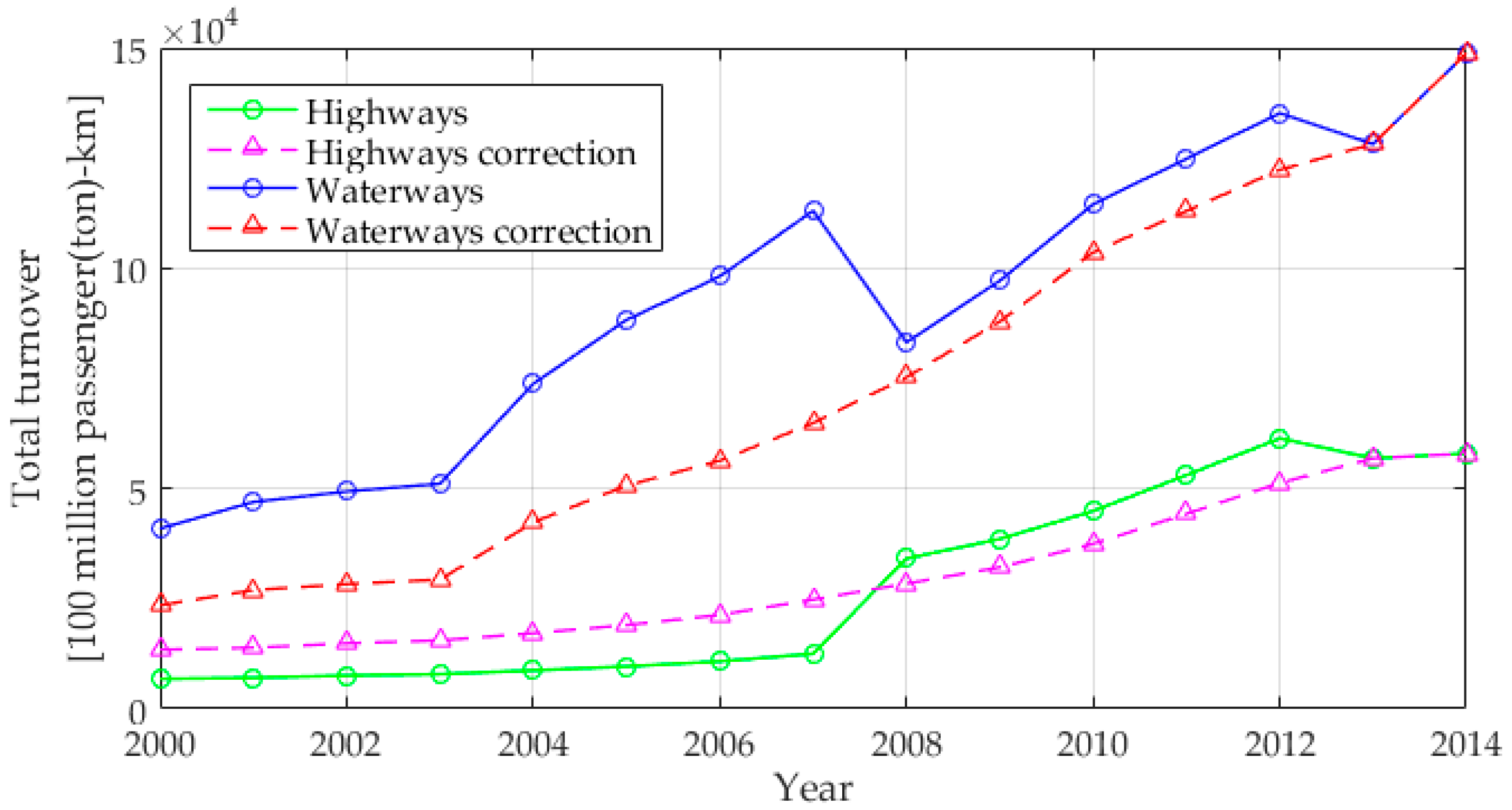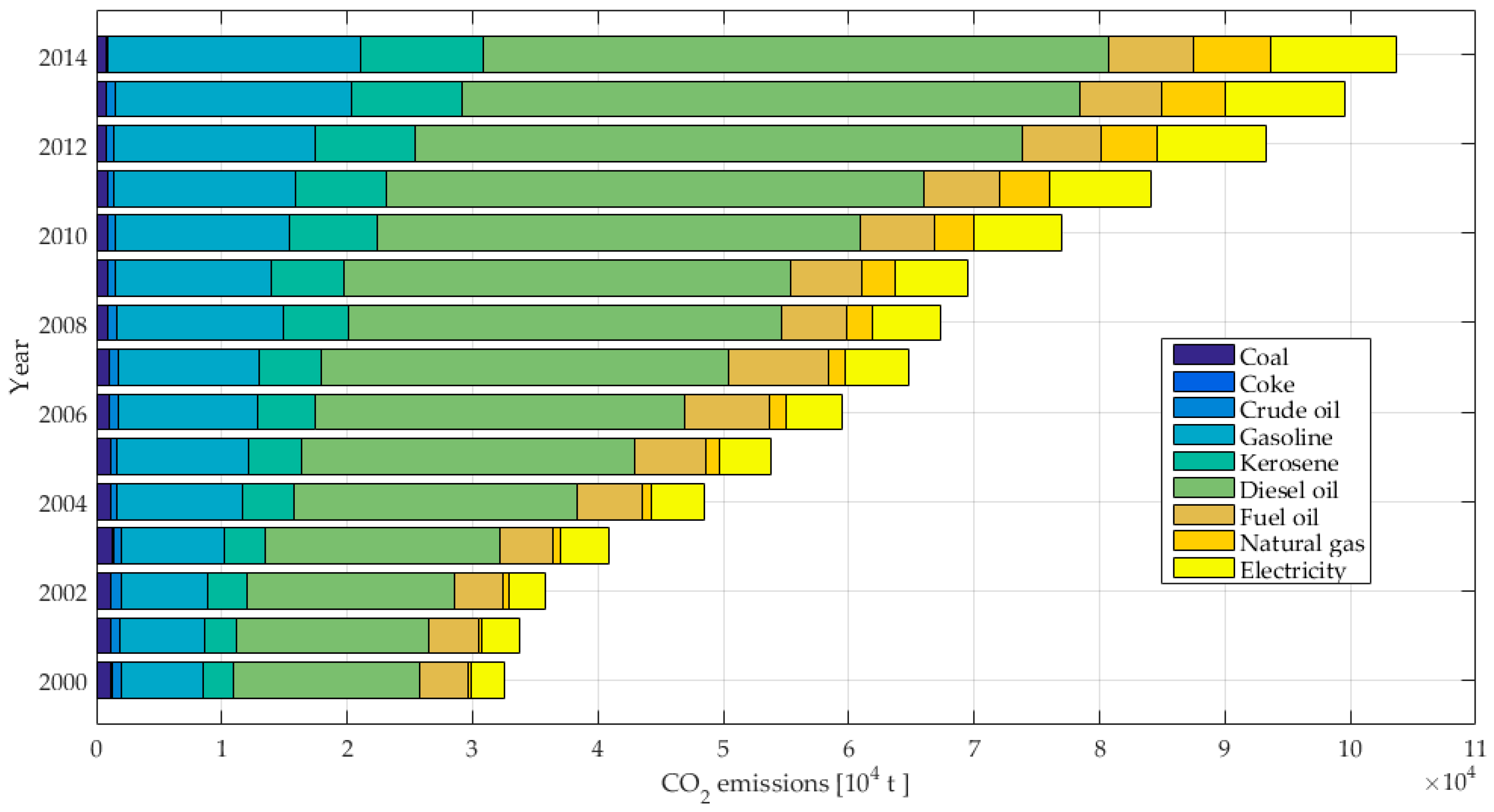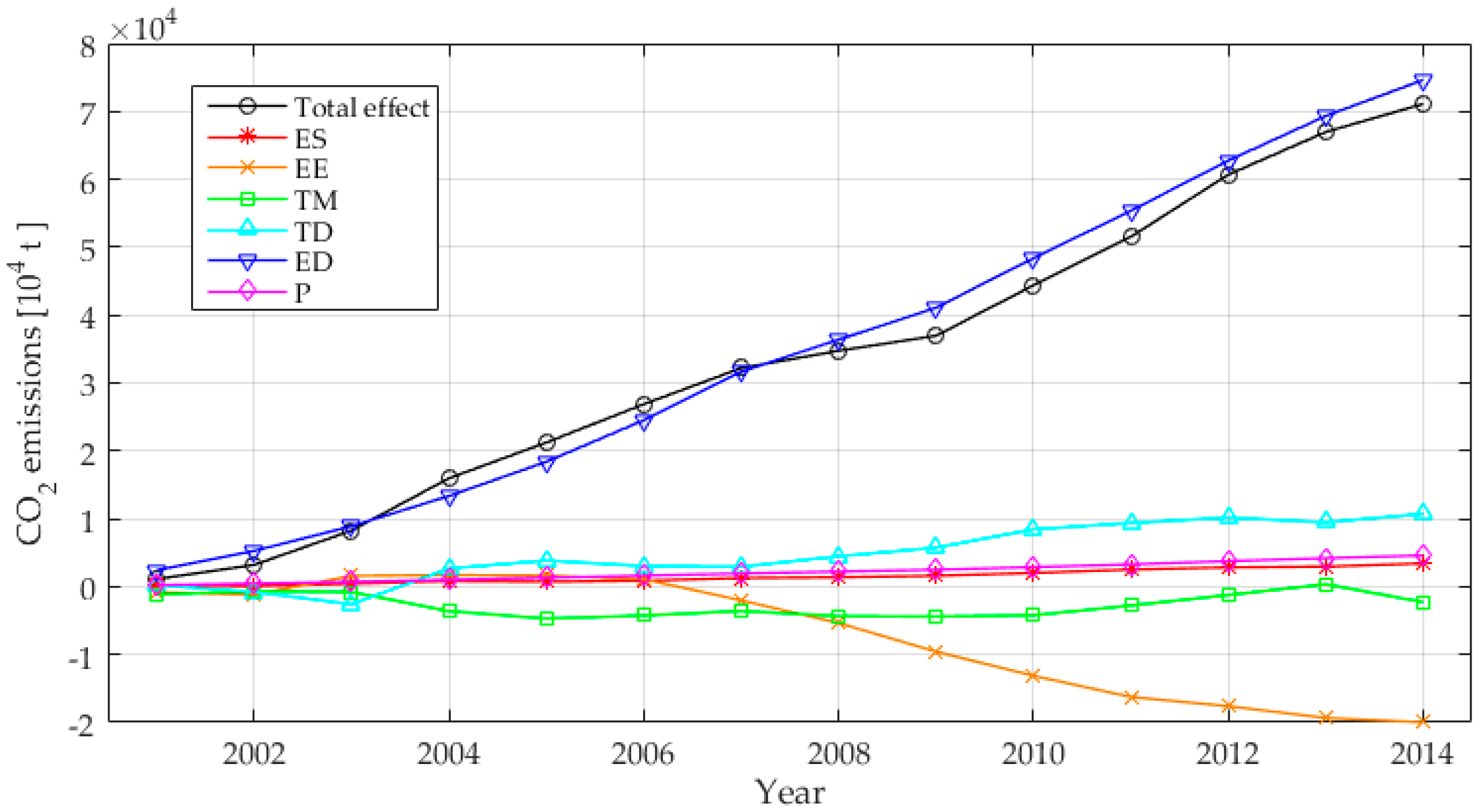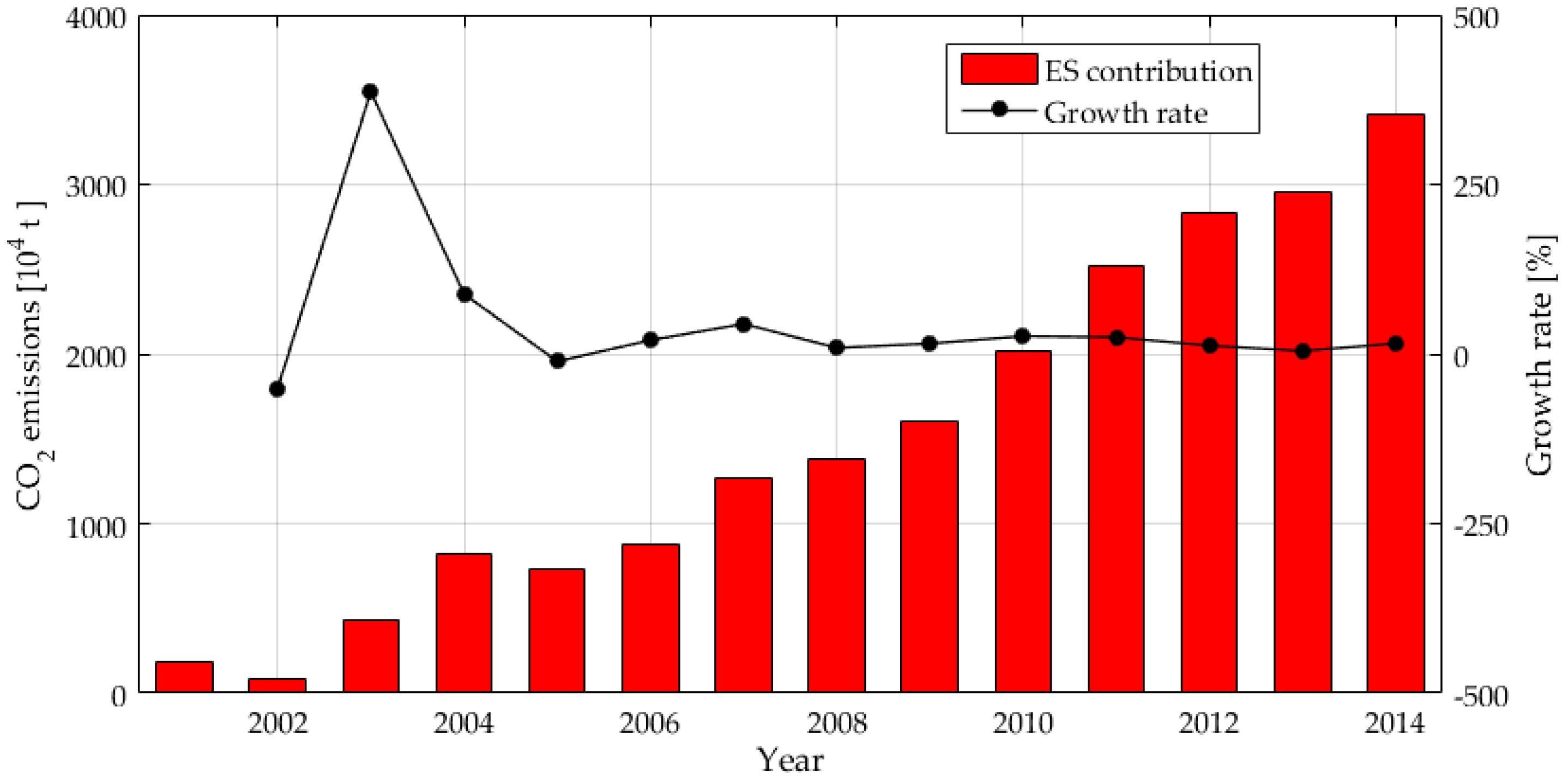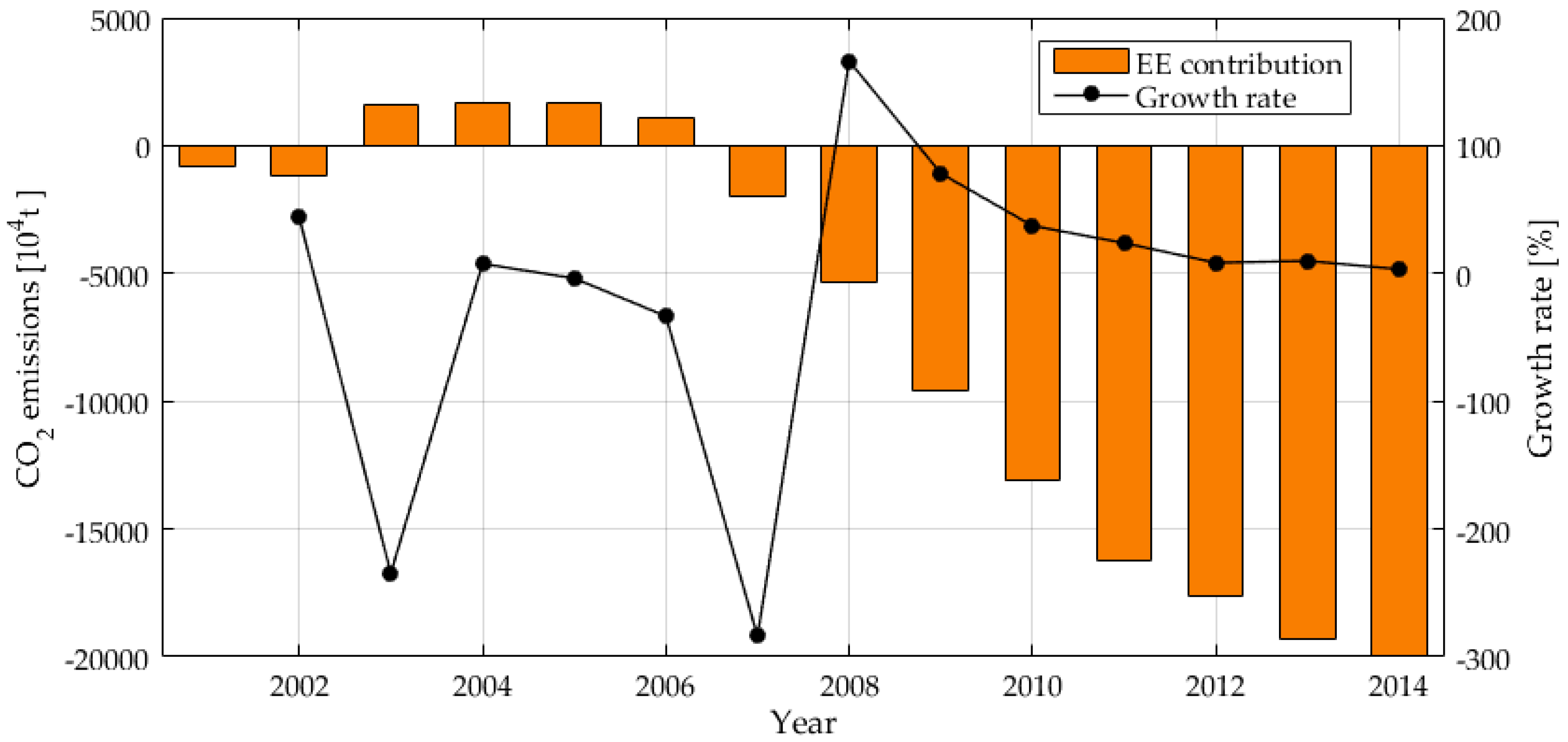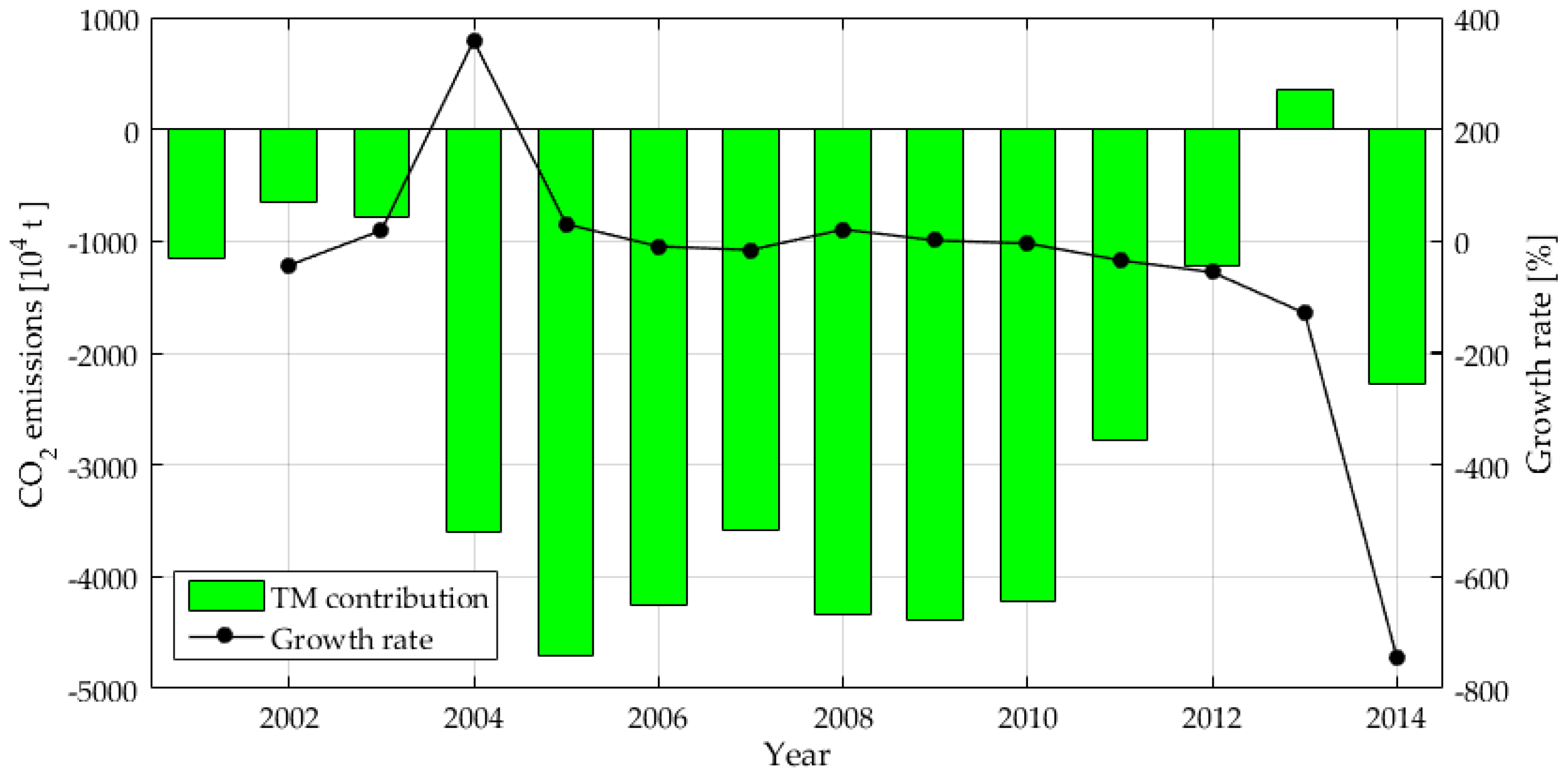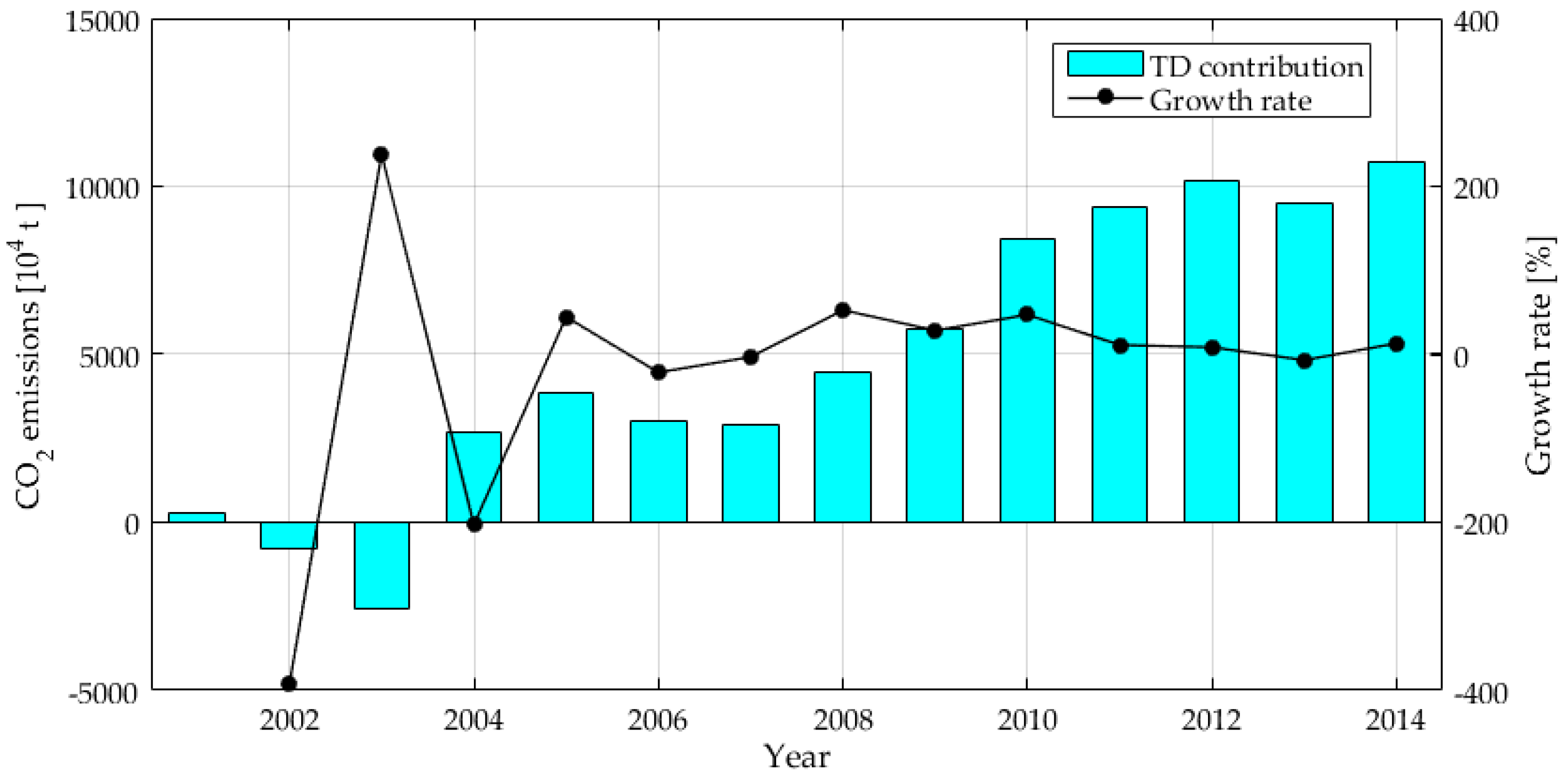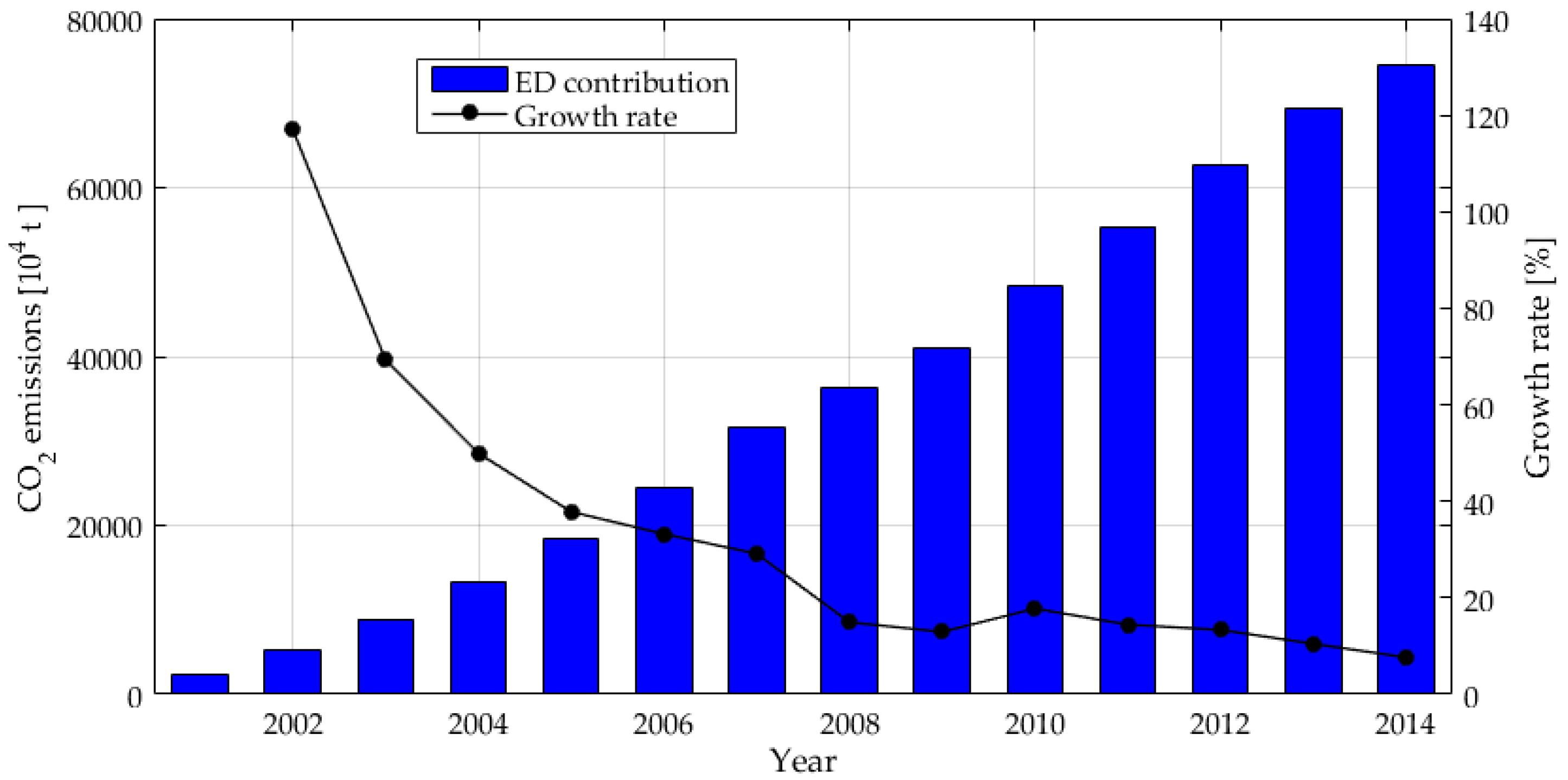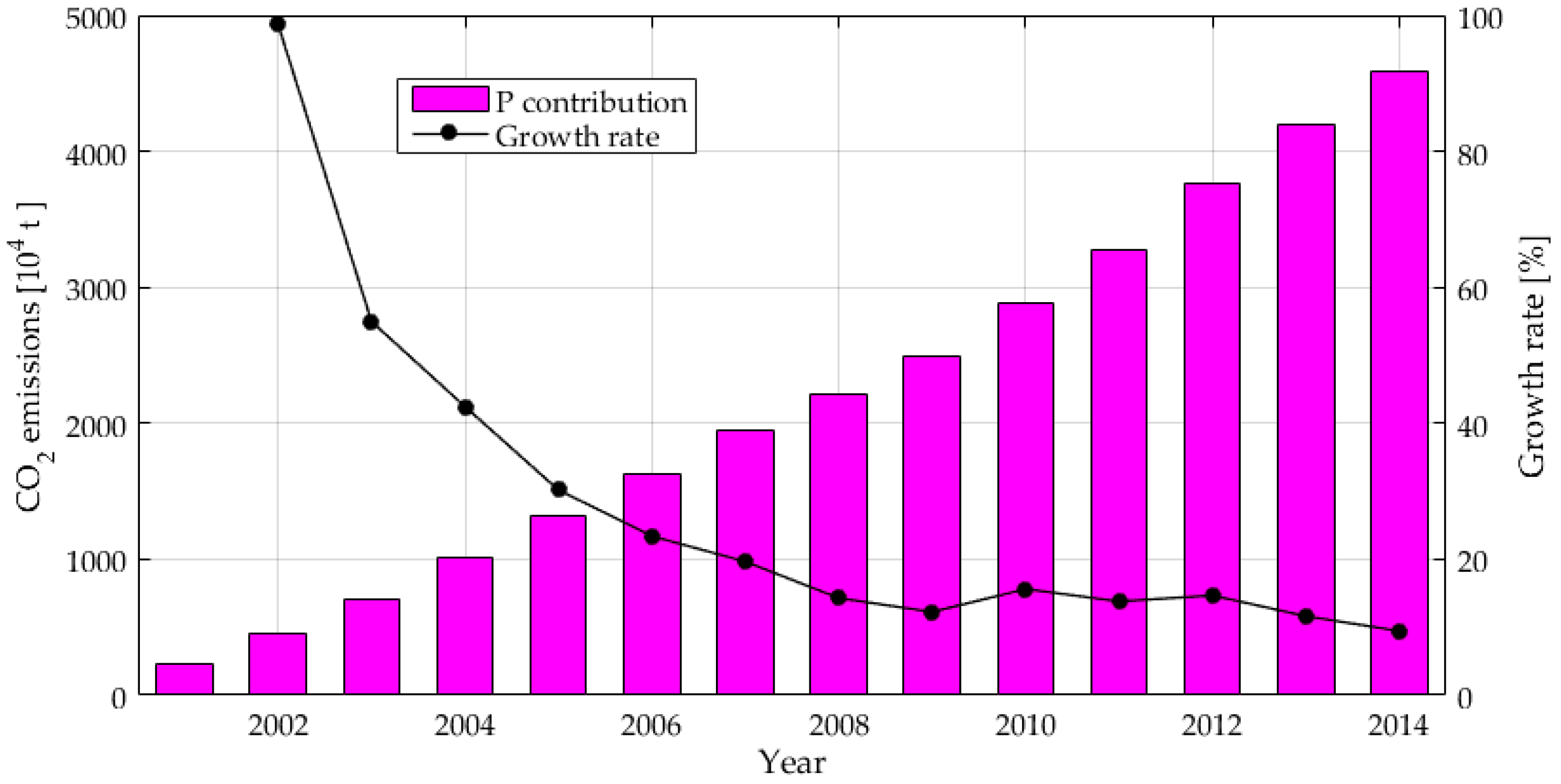5.1. CO2 Emissions
To make a clearer and more intuitive analysis of the changing trend of CO
2 emissions related to transportation sector, calculation results of
Table A7 are illustrated in
Figure 2. It can be seen that, though the growth rate fluctuated sharply, CO
2 emissions of transportation sector in China overall showed an upward trend over 2000–2014. Compared with the amount in 2000, the total CO
2 emissions increased by 71111.34 ten thousand tons in 2014, with an average annual growth rate of 8.7%. It is because that during 2000 to 2004, China’s economy developed dramatically, leading to the great CO
2 emissions growth rate of transportation sector; in 2005,
the Kyoto Protocol was forced to take effect [
30], at the same time, China’s energy conservation and emissions reduction policy implementation achieved remarkable results. As a result, the growth rate decreased gradually until 2008; in 2009, under the background of global financial crisis, the policy of expanding domestic demand was implemented, and a large number of public infrastructure was constructed to stimulate domestic economic development, leading to rapid development of transportation and increase of CO
2 emissions; In 2012, the State Council issued
The Energy saving and emission reduction planning in 12th Five-Year [
31], which made a more stringent emission reduction target for the transportation sector that the comprehensive energy consumption of all kinds of transport forms should be reduced by more than 5%. From then on, the growth rate of CO
2 emissions tended to decline.
From
Figure 3, during 2000 to 2014, overall, CO
2 emissions of various energy sources related to transportation demonstrated an increasing trend. Specifically, CO
2 emissions generated by natural gas, kerosene and electricity climbed up significantly. For natural gas, the contribution value went up from 253.35 ten thousand tons in 2000 to 6166.13 ten thousand tons in 2014 with an annual average growth rate of 26.48%, whose total growth rate exceeded more than 371%. CO
2 emissions due to kerosene consumption rose from 2379.68 ten thousand tons in 2000 to 9840.37 ten thousand tons in 2014 with an average growth rate of10.94%. As for the CO
2 emissions due to electricity consumption, it soared up from 2683.93 ten thousand tons in 2000 to 10106.21 ten thousand tons in 2014, whose average growth rate reached 10.28%. It is acknowledged that coal, coke and crude oil are main energy sources of China, however, with the upgrading of China’s industrial structure as well as new alternative energy development and utilization, the consumption of these three energy sources has been gradually decreased. Enormous CO
2 emissions due to coal, coke and crude oil consumption from 2000 to 2003 were, after 2003, with the decrease of coal, coke and crude oil consumption, CO
2 emissions related to transportation had been reduced significantly. In 2014, 958.39 ten thousand tons of CO
2 caused by coal, coke and crude oil consumption were emitted, which decreased by 1012.34 ten thousand tons compared with that in year 2003 when the emissions reached 1970.73 ten thousand tons, and the total reduction rate outnumbered 50%. Diesel oil, gasoline and fuel oil are main sources of CO
2 emissions followed by natural gas, kerosene and electricity. In detail, the average growth rates of gasoline and diesel oil were 9.17% and 8.59% respectively. For fuel oil, in 2008, CO
2 emissions due to fuel oil compared to the emissions in 2007 decreased by 2795.44 ten thousand tons, and in 2009, it was only 488.58 ten thousand tons more than the amount in 2008 because of the reduction of freight volume caused by financial crisis.
Overall, traditional energy sources consumed by the transportation sector such as gasoline and diesel oil still play a predominant role in CO2 emissions, but the growth trend has slowed down. On the one hand, with the quick updates of transportation facilities, high-speed railways which consume electric power energy have rapid developed in recent years. On the other hand, the introduction of new energy technologies and the government’s active support policies have led to the rapid rise for natural gas vehicles and hybrid electric vehicles. As a result, though the growth rate of CO2 emissions from natural gas and electricity is increasing year by year, as compared with traditional energy sources, these clean energy sources can effectively alleviate the enormous pressure of CO2 emissions in China.
5.2. Decomposition Analysis of Factors Affecting CO2 Emissions
To make a more clear and intuitive analysis of the contribution effect of factors affecting CO
2 emissions, the calculation results of
Table A8 are illustrated in
Figure 4. It can be seen that, overall, CO
2 emissions related to transportation showed a growing trend over the study period. Among six kinds of influencing factors, economic development, transportation development, population size and energy structure significantly drove the growth of CO
2 emissions. Specially, economic development was the key contributor to stimulate CO
2 emissions growth. In contrast, energy efficiency and transport form played an inhibitory role in CO
2 emissions. Energy efficiency suppressed CO
2 emissions growth dramatically. Detailed analysis are represented in the following paragraphs.
(1) Effect of energy structure on CO2 emissions growth
Figure 5 shows the contribution effect of energy structure on CO
2 emissions growth.
As shown in
Figure 5, setting year 2000 as the base year, from 2001 to 2014, the energy structure still had a positive effect on CO
2 emissions whose overall trend was upward. In 2002 and 2005, the contribution effect declined slightly compared to the previous year and the reduction reached 90.82 ten thousand tons and 89.56 ten thousand tons respectively. In 2003 and 2004, CO
2 emissions shot up sharply with the growth rate of 386.76% and 88.50%. In other years, the data showed a slight upward trend with an average growth rate of 19.21%. Further, decomposing the energy structure factor into coal, coke, crude oil, gasoline, kerosene, diesel oil, fuel oil, natural gas and electricity, their contribution effects are shown in
Table A9 and
Figure 6.
As can be seen from
Table A9 and
Figure 6, from 2001 to 2014, the differences between energy consumption and energy structure led to the fluctuation of CO
2 emissions. Three energy sources-containing coal, coke and crude oil, whose average contribution rates respectively were −27.18%, −1.68% and −18.07%, had a negative inhibitive effect on CO
2 emissions as a result declining dependence of the transportation on these three energy sources. Obviously, natural gas and electricity consumption contributed a lot on CO
2 emissions growth. Among them, CO
2 emissions due to natural gas consumption rose from 51.34 thousand tons in 2001 to 3519.8 thousand tons in 2014, with an average growth rate of 47.45%; for electricity, the amount of CO
2 emissions surged from 272.29 ten thousand tons in 2001 to 5426.13 ten thousand tons in 2014, with the average growth rate of 38.72%. It is worth noting that, taking the CO
2 emitted by thermal power generation into account made the electricity a major contributor for CO
2 emissions growth. As a matter of fact, for equal traffic volume, CO
2 emissions generated by electricity consumption are much lower than that generated by fossil fuels. Therefore, the contribution effects of natural gas and electricity consumption to CO
2 emissions shows that the use of clean energy in transportation of China is gradually increasing, and its proportion of energy consumption structure is expanding as well. At the same time, this phenomenon inhibited the growth trend of gasoline consumption, making the contribution effect of gasoline to CO
2 emissions be a negative value which reached −2206.00 ten thousand tons in 2014, with the average contribution rate of −120.59%. As a main energy source of traditional waterways transportation, fuel oil played an inhibitory role in CO
2 emissions growth, whose decrement attained 1155.85 ten thousand tons from −35.43 ten thousand tons in 2001 to −1191.28 ten thousand tons in 2014,with the average contribution rate of −41.54%. The maximum inhibition effect of fuel oil appeared in 2002 with the contribution rate of −132.28%. Diesel and kerosene consumption accelerated CO
2 emissions growth on the whole. Among them, the contribution effect of diesel oil fluctuated dramatically with negative values in 2003, 2004 and 2014 and an average value of 587.58 ten thousand tons in other years. The contribution effect of kerosene is relatively small who approximately remained at 162.88 ten thousand tons. Overall, even though the proportion of clean energy consumption has climbed up, there is still much room for improvement, so optimizing energy structure is still the main direction of suppressing CO
2 emissions growth. Therefore, the governments are supposed to vigorously carry out clean energy advocacy, collaborate strongly with trade associations and enterprises, supply transportation enterprises with more national policy support and incentives, and continue to strengthen the use of natural gas, electricity and other clean energy to gradually get rid of the dependence on diesel consumption.
(2) Effect of energy efficiency on CO2 emissions growth
Figure 7 shows the contribution effect of energy efficiency on CO
2 emissions growth.
As can be seen from
Figure 7, energy efficiency factor restrained the growth trend of CO
2 emissions on the whole. In detail, the dynamic changing process can be divided into three stages: in 2001 and 2002, energy efficiency inhibited CO
2 emissions growth with a gradually enhanced effect and the average contribution value reached −1001.02 ten thousand tons; during 2003–2006, energy efficiency promoted CO
2 emissions growth with an average contribution value of 1509.51 ten thousand tons , and its contribution effect increased at first and then decreased, which reached the peak of 1709.31 ten thousand tons in 2004. Rapid development of transportation sector, and implement of high-energy consumption and high-emission development model in most enterprises were supposed to be responsible for this phenomenon; during 2007–2014, it can be found that energy efficiency demonstrated a growing ability in inhibiting CO
2 emissions whose contribution value fell down from −2013.66 ten thousand tons in 2007 to −19975.64 ten thousand tons in 2014 with an average value of −12903.54 ten thousand tons. Moreover, the negative effect at this stage far overwhelmed the promoting effect at the previous stage. Viewing the situation from a whole, the improvement of energy efficiency of transportation sector contributed a lot to restrain the growth of CO
2 emissions, which brought enlightenments for China to promote economic restructuring, improve the ecological environment and protect non- renewable resources.
(3) Effect of transport form on CO2 emissions growth
Figure 8 shows the contribution effect of transport forms on CO
2 emissions growth.
It can be seen from
Figure 8 that transport form showed a strong inhibitory effect on CO
2 emissions. Specifically, the whole analysis period can be divided into three stages: from 2001 to 2003, the contribution effect of transport form, whose average contribution value equaled to −867.16 ten thousand tons, was relatively weak and showed a decreasing trend year by year; during 2004–2010, the factor of transport form maintained a strong effect on inhibiting CO
2 emissions when the average contribution value reached −4154.67 ten thousand tons, specially, in 2005, the inhibitive effect reached its peak with the contribution value of −4698.34 ten thousand tons; during 2011–2014, the inhibitive effect of transport form demonstrated a tendency to rebound, especially in 2013, the contribution value turned to be positive from negative, and the inhibitory effect turned to be promoting effect. Further, decomposing transport form factor into railways, highways, waterways and civil aviation respectively, the contribution values of the four transport forms are shown in
Table A10 and
Figure 9.
From
Table A10 and
Figure 9, it is evident that waterways and civil aviation played an important role in driving CO
2 emissions growth. Among them, the contribution value of waterways whose pulling effect was obvious and significant increased from 267.65 ten thousand tons in 2001 to 2843.86 ten thousand tons in 2014, with an average contribution value of 1610.92 ten thousand tons; the contribution value of civil aviation whose pulling effect was not obvious increased from −217.8 ten thousand tons in 2001 to 1200.67 ten thousand tons in 2014, with an average contribution value of 551.89 ten thousand tons; in contrast, railways and highways inhibited CO
2 emissions. Inhibition value of railways changed from −126.92 ten thousand tons in 2001 to −5186.92 ten thousand tons in 2014, with an average contribution value of −2048.35 ten thousand tons, and this inhibitive effect exceeded the pulling effects of waterways and civil aviation, thus explaining the reason why transport form restrained CO
2 emissions growth. As for highways, its contribution effect fluctuated dramatically especially in 2005 when the inhibitive effect reached its peak with the contribution value of −5500.88 ten thousand tons. In 2013, the inhibitive effect of highways turned to be pulling effect with the contribution value of 1511.57 ten thousand tons, causing the pulling effect of transport form factor; however, overall, the highways still played a strong inhibition role in CO
2 emissions. The study [
32] showed that under the premise of the same traffic volume, the energy consumption ratio of railways, highways and civil aviation is equal to 1:9.3:18.6. From the perspective of passenger transport, CO
2 emissions per kilometer per passenger generated by railways is 1/2 times that of highways and is 1/4 times that of civil aviation. From the perspective of freight transport, CO
2 emissions per ton per kilometer generated by railways is 1/10 times that of highways. It follows that railways has unparalleled advantages in promoting energy efficiency and environment protection compared to other transport forms. It can be concluded that with the rapid development of high-speed railways and the introduction of new energy vehicles, to a certain extent, China’s transportation structure has improved. However, for the total effect of CO
2 emissions, the suppressing effect of transport form is still not evident enough, and it is necessary to take transport distance, cost, duration and other factors into consideration and choose reasonable modes of transport to avoid empty driving, repeat, detour and other unreasonable transport phenomenon.
(4) Effect of transportation development on CO2 emissions growth
Figure 10 shows the contribution effect of transportation development on CO
2 emissions growth.
As can be seen from
Figure 10, transportation development stimulated CO
2 emissions growth on the whole. Specifically, it can be divided into two stages: from 2001 to 2003, the contribution values turned from positive to negative, and in 2003, the contribution value was −2589.5 ten thousand tons, obviously inhibiting the growth of CO
2 emissions; during 2004–2014, the effect of transport development showed an increasing trend with some fluctuations with an average contribution value of 6440.60 ten thousand tons. The factor of transportation development is measured by ratio of comprehensive turnover volume to GDP. From
Table A6 and
Table A7, the growth rate of comprehensive turnover volume was less than the growth rate of GDP in 2001–2003, while during 2004–2014, the growth rate of comprehensive turnover volume which increased after decrement in the study period, turned greater than that of GDP adversely, indicating that with the improvement of transportation structure, the comprehensive transportation volume brought by unit GDP continuously went up gradually. Along with this changing process, the energy consumed by transportation sector climbed up and that led to the effect of driving CO
2 emissions related to transportation development.
(5) Effects of economic development and population size on CO2 emissions growth
Figure 11 and
Figure 12 respectively show the contribution effects of economic development and population size on CO
2 emissions growth.
As seen from
Figure 11, economic development played a significant role in promoting CO
2 emissions growth. During the study period, economic development showed an exponential growth trend, whose contribution value soared up from 2424.02 ten thousand tons in 2001 to 74634.24 ten thousand tons in 2014, increasing by 72210.22 ten thousand tons with an average contribution rate of 113.80%. There may be two main reasons: first, the improvement of people’s income level and the increase in travel demand made the demand for vehicles climb up. Along with the increasing demand for public transport, a large number of families purchased private cars, which led to the significant pulling effect of economic development level on CO
2 emissions of transportation sector. Another reason is that, with the development of electronic commerce, electronic business has become a new business mode and express delivery get a rapid development. Meanwhile, the disorderly development of lots of express companies and city distribution logistics had led to CO
2 emissions growth of transportation sector to a certain extent. According to
Figure 4, it demonstrated that economic development trend was consistent with the development trend of total effect, reflecting that economic development was the most important driving force for CO
2 emissions. From
Figure 12, the factor of population size also had a stimulating effect on CO
2 emissions growth whose contribution value increased from 230.3 ten thousand tons in 2001 to 4592.24 ten thousand tons in 2014 with an average contribution rate of 8.07%. Besides, the contribution effect of population size was relatively weaker than that of economic development.
